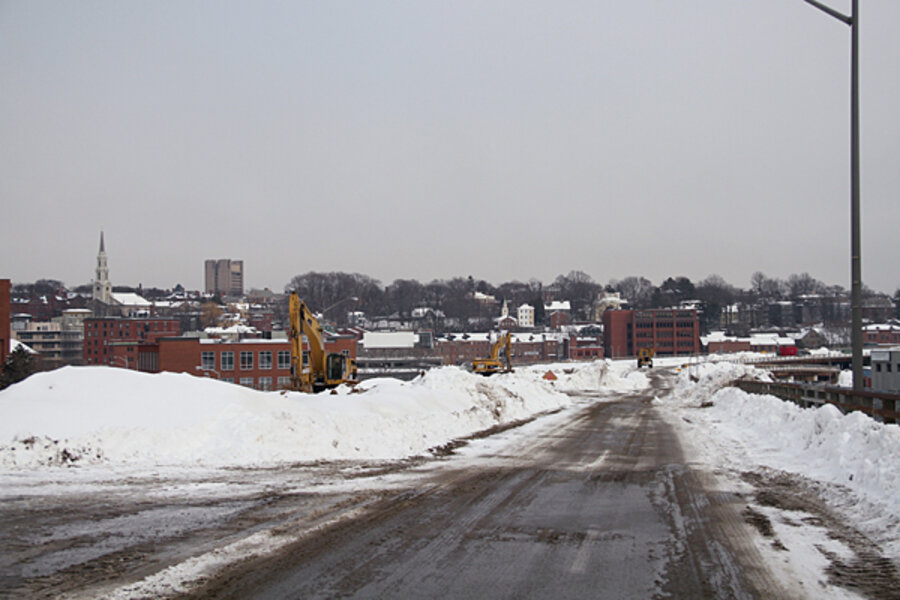Downtown need a makeover? More cities are razing urban highways
| New Haven, Conn.
In New Haven, Conn., a mistake of the past – one that displaced hundreds, razed a neighborhood, and physically divided a city – is finally set to be rectified: A highway is going to be demolished.
Some people in New Haven have been waiting to see this for 40 years, ever since it became clear that a modern roadway slicing through the heart of downtown would not bring the hoped-for suburban shoppers and revitalization. That waiting list is long, it turns out, as cities across the United States look to erase some of the damage from urban highway construction of the 1950s and '60s – tearing up or replacing the roadways and attempting to restitch bulldozed neighborhoods.
"For people who live and work around [urban highways], they always had huge negative side effects: They broke up the urban fabric, were noisy, and divided cities," says Ted Shelton, a professor of architecture at the University of Tennessee who has studied urban highway removal. Removing roadways presents an opportunity for wiser, gentler redevelopment that can – if all goes well – add vibrancy and livability to areas around city centers.
That possibility has planners from Providence, R.I., and Baltimore to New Orleans and Seattle rethinking decisions to run highways through the hearts of cities. To that end, they are hoping to get some help from federal transportation programs (though budget-cutters in the US House have this program in their sights), as well as from local and state sources. New Haven's $16 million from Uncle Sam, for instance, will help demolish a short stub of highway – called the Oak Street Connector – that delivers visitors to a Walgreens and a parking garage.
Two things are driving these extreme make-overs. One is the simple fact that many highways built in the postwar years are nearing the end of their useful lives, says Joseph DiMento, a professor of planning and law at the University of California, Irvine, who is at work on a book about urban highways. The other, he says, is a growing faith that urban centers, including some that have been long neglected, have development potential.
Still, he cautions, not every city can reclaim its downtown by ripping up highway, because the highway may not be the biggest problem.
"You can't isolate freeway intervention as the only factor in the depopulation of many Rust Belt and Snow Belt cities. It was a factor but not the only factor. People were moving out independently," Mr. DiMento says.
Those who hope the post-highway landscape will right wrongs and make things the way they used to be will probably be disappointed. New Haven's removal project, set to evolve in phases, will try to reconnect city streets long separated by the highway. But where lower-end housing and a predominantly African-American neighborhood once stood, city officials now pin their economic hopes on a 10-story medical lab and office building.
"It's pretty audacious to take out a highway," says Kelly Murphy, city economic development administrator. But "we're not going to build four-story walk-ups anymore." Restitching a city must accommodate the modern role of cities, not just nostalgic visions of the past, she notes.
In Baltimore, demolition is under way on the "highway to nowhere," which displaced almost 3,000 residents on the city's west side when it was constructed more than four decades ago.
"It tore apart the social fabric of the community, and it created division. For those communities, it was the last nail in the coffin," says Jamie Kendrick of the Baltimore City Department of Transportation. The highway's removal was motivated in part, he says, by the "idea that these communities that suffered injustice 40 years ago are finally able to correct some of that injustice."
The highway is slated to be replaced by a light-rail public transit station and parking lots, a temporary measure, Mr. Kendrick says, until the troubled area becomes attractive to burgeoning biomedical industries downtown.
Muriel Praileau, a West Baltimore resident and retired social worker, remembers when her old neighborhood was torn down. "I hope that the [highway removal] will reconnect the community and make for a more harmonious relationship with the area," she says. But given the area's "deterioration, heaven knows what may happen at this stage," she adds.
In Providence, Rhode Island transportation officials opted to reroute a dilapidated section of highway, moving the road outside the downtown core at no small expense. Demolition began late last year.
Now, "there's an opportunity not only to create a new neighborhood but to sort of reinvent our downtown," says Robert Azar, a planner with the Providence Department of Planning and Development.
Boosters of urban highway removal acknowledge the difficulties of repairing city fabrics after roadways are scaled down. Tearing them down "is not like it's a magic thing that suddenly everything's fine," says John Norquist, president of the Congress of New Urbanism.
But Mr. Norquist's own experience while mayor of Milwaukee proved to him that losing a highway can be a blessing. Milwaukee's massive highway removal project is generally hailed as a success, opening up the city's downtown. Sections of the former freeway space, though, remain undeveloped, the victims of fluctuating developer interest, ownership divisions, and the recent recession.
Norquist sees the rising desire of cities to rid themselves of highways as a hopeful sign that past mistakes will not be repeated. "If Paul had been facing a grade-separated highway on the road to Damascus," quips Norquist, "maybe he wouldn't have seen the light."





